How to Build Automation Email Marketing for eCommerce?
For online retailers, email marketing automation is an effective customer retention tool. The problem is that many businesses are unsure which automated email campaigns are worth prioritizing and running.
Adopting email marketing has major benefits. According to a VentureBeat Insight report, it has the highest return on investment (ROI) of any of the most popular digital platforms, earning companies an average of $38 for every dollar invested.
According to the study, “84 percent of marketers believe email is very important for customer loyalty.” Email remains a powerful method of encouraging repeat transactions, reducing the eCommerce business’s reliance on the often unreliable influx of new customers. Email marketing contributes to the growth of your brand and the acquisition of more loyal customers who spend more money with you. Email has the ability to provide long-term value to your company with only a few starter campaigns, and unlike traditional one-to-one business email formats, you can automate this process. In reality, nearly every eCommerce company will profit from implementing one of these seven automated email campaigns.
In this article, I will share with you everything you need to know about automation email marketing for eCommerce businesses, and how you can use it to grow your business. Let’s jump right into the details!
What Is Automation Email Marketing?
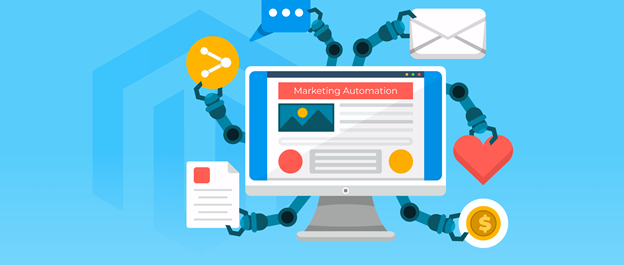
Automation email marketing is the method of scheduling email campaigns to be sent based on a cue or an elapsed time span.
For example, you have planned that you need to send a welcome email when a customer first signs up for newsletters or creates an account on your eCommerce store.
However, doing this manually each time you received a new subscriber would be very exhausting.
Instead, you can schedule a welcome email to be sent to your new subscribers/customers on a regular basis.
However, email marketing automation can go far beyond basic welcome emails. You can personalize them based on your customers’ data, their actions with your emails, and their product preferences.
This means that you can always deliver the right message at the right moment, without having to exhaust yourself.
And this is probably the most important advantage of automation email marketing. There are also additional advantages of using automated email workflows.
Benefits of Automation Email Marketing
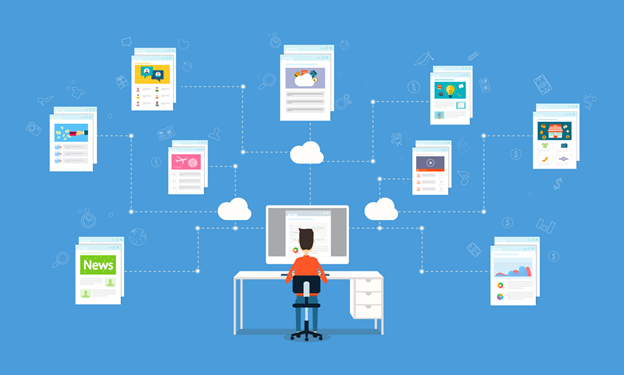
Automating email marketing has many great benefits when it comes to eCommerce.
- Email automation will help you greatly increase sales. Their conversion rate is 359% higher than that of promotional campaigns.
In reality, automation marketing messages accounted for 29 percent of all email orders in 2020, despite accounting for less than 2 percent of all email sends.
Given that seven out of every ten carts are abandoned, recouping more than 2% of those lost sales is astronomically fine.
-
Automation marketing emails are more relevant to your customers. This means you won’t be blasting messages to your customers for no reason—they’ll be contextual and delivered at the right moment.
-
Automated emails do not replace traditional newsletters; rather, they supplement them. Automation marketing email flows assist you in developing reliable brand communications.
Your emails should not always be promotional. You could send a “thank you” email after they make a purchase or a “birthday” email on their special day. They can all be automated and sent while you sleep.
-
Marketing automation saves you time. You set up emails once, and they operate on themselves after that.
-
You remain one step ahead of your rivals. According to LeadSpace, nearly 82 percent of businesses use email automation in some way. You’re missing out if you don’t implement automation email marketing for your business.
But to implement automation email marketing properly, you need to have the right strategies to make the most out of your efforts. Here’s how you can get started.
How to get started with automation email marketing?

Collect Lead Information
Place lead forms on your website, landing pages, and ads if you haven’t already to gather information from your prospects.
These landing pages can be generated based on the details you choose to use - common fields include name, email address, business, budget, sector, and location.
Learn more: Top 15 Lead Generation Companies
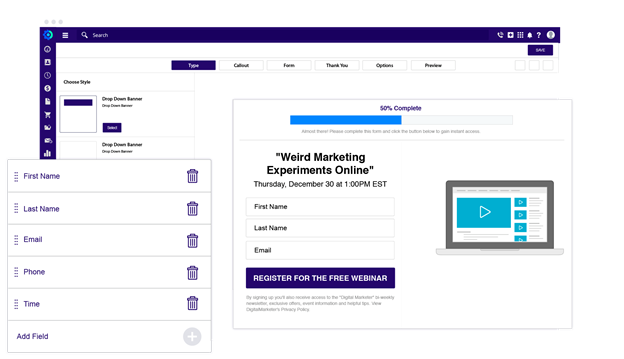
Choose a Goal
You’ll need to decide what action you want to drive through automated email marketing, just as you would for any other marketing campaign.
Of course, you want high open and click-through rates, but do you want them to subscribe for a product demo?
Do you want conversions or a minimum amount of purchases? What about dialing a number, making a donation, signing up for a newsletter?
Once you’ve developed your target, you can work backward to build the content for your email automation campaign.
Determine Qualifying Criteria
To move leads through your sales funnel, you’ll need to score them. You can determine your own scale, but your marketing automation system might already have suggestions.
Some general guidelines: you can disqualify based on location (e.g., outside of your distribution range), budget, business, and so on.
Consider rating your lead higher if they have the exact work title or political party affiliation that you’re going to target with your campaign.
In terms of your marketing content, less actionable pieces should be assigned a lower score, say 1 or 2.
Marketing material that converts and tells a lead about your product is more important, so the sales team can spend less time on the phone.
You should provide case studies, product marketing materials, demonstrations to move customers towards the “completion” stage of your email automation campaign. It all depends on what you want to achieve!
Create Content for the Funnel
Start with what you already have. What generates the most clicks and opens? What exactly is a major converter?
Will your sales team have any favorite blog posts, case studies, or product one-pagers that really pique the interest of prospects?
Once you’ve accumulated an arsenal of valuable marketing material, you can begin to fill in these blanks.
Test, test, and test
You’ll need to test everything, just as for every new marketing strategy or platform, before you discover your sweet spot.
It’s unlikely that automated email marketing won’t work for your business, but you’ll need to put in some effort to find the right messaging and scoring to effectively move leads down the funnel or convert them. Here are some basic testing tips:
-
Create different email copies. Instead of making three variants on “buy now!” consider having variations that inspire different behaviors or look at the value proposition from different perspectives.
-
Create different email templates. You should be able to A/B test email formats to see if longer-form emails perform better, plain-text vs. Javascript, CTAs above the fold, or simple navigation at the top of your emails.
-
Send at different times. To find the best time to get engagement, play with various times of day, days of the week, and so on.
-
Subject line and preheader text. As with the copy tip above, write variations for each subject line to see which gets the most opens.
-
Test your scoring. Although you may already be aware that requesting a demo is a qualifying move, a case study may not be.
Or, contrary to popular belief, a whitepaper is more of a branding initiative than you would think. Be adaptable and meet with your sales team to decide the best way to score your leads.
Read more: How to start A/B testing in email marketing?
Monitor touchpoints
It’s likely that email isn’t the only way you’re communicating with your prospects. Bear in mind that your automation email campaign does not exist in a vacuum. If these leads are retargeted on ad networks or emailed outside of the nurture campaign, don’t overwhelm them with your ads to avoid ad fatigue.
Analyze and Optimize
This last one is self-evident. Set realistic expectations and performance indicators after the campaign goes live.
As you go, make adjustments. All marketing automation systems have analytics dashboards that allow you to track performance; you should also keep an eye on the number of emails sent every day. If leads are being qualified before they hit the bottom of the funnel, that’s fantastic!
Reduce the number of emails in the queue to ensure that the most important material is distributed as quickly as possible.
The opposite is true; increase the number of emails sent to qualify prospects before they are ready to convert.
Great examples of automation email marketing for eCommerce
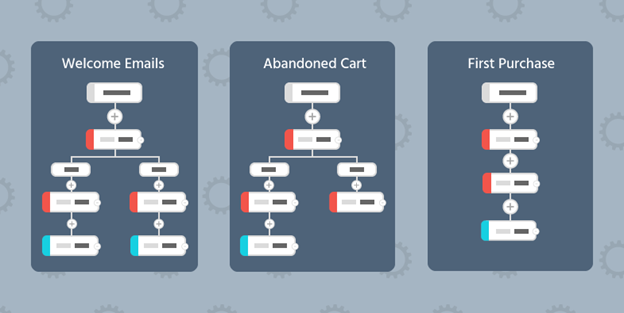
I understand if you’re still feeling lost and frustrated about what kind of emails you should choose for your automation email marketing.
To help you out with that, I’ve gathered some more fantastic email examples to help ignite your imagination.
Welcome email
When you acquire a new subscriber, you should welcome them to your list, introduce them to your products, and simply confirm that they will receive your future emails.
Welcome emails are a perfect opportunity for your brand to shine; they should be fun and informative.
It used to be standard practice to include a discount in your welcome email, which I still recommend, but nowadays, you’ll find a rundown of the company, followed by a series of category-specific sections and CTAs.
Emphasizes their brand voice, provides a discount at the bottom, and contains some useful tips on why you should select Casper in the body. Learn more: Setup Welcome email series for new subscribers
Feedback email
Asking for constructive criticism is a perfect way to involve your subscribers in your business; they will feel important and honored that you asked, and you will gain an opportunity to improve as a result.
This Revolution Tea email asked for reviews, and then kept you posted on the outcome, and then offered a discount code!

Blog post email
This is a simple one: if you create new material, spread the word about it. If you have famous content that you want your subscribers to see, send it to them via email.
These emails are low-risk and high-reward; if your subscribers click through and read your message, they’re likely to be much more involved in your brand.
Wistia accomplishes this by highlighting some informative articles from guest authors—a brilliant way to provide subscribers with a range of options.

Informational email
As you move your subscribers through your automation email funnel, you’ll want to demonstrate that you’re worth their time.
That is when informational emails come in handy. This is an excellent opportunity to illustrate your (possibly complicated) offering, demonstrate how your pizza is made with love, or highlight the clients you’ve helped to succeed.
In one simple infographic, Ritual’s email breaks down exactly what you’re bringing into your body when you take their supplements.

Re-engagement email
Your audience will sometimes forget about you. Don’t take it personally; the world is a messy place right now.
But use this as a reason to politely remind them that you’re still here and waiting for them to return!
Airbnb accomplishes this by nudging their subscribers into the magical places they might be living, complete with a price in the email—much like airline emails on their cheapest flights.

Milestone email
Birthdays should be celebrated! Or the anniversaries of annual subscriptions! Or New Year’s, the Fourth of July, Thanksgiving, the company’s anniversary, and so on.
I’m a huge fan of half-birthdays, which is why I love the email from Outdoor Voices below! What a perfect way to remember a little event with a free coupon code.
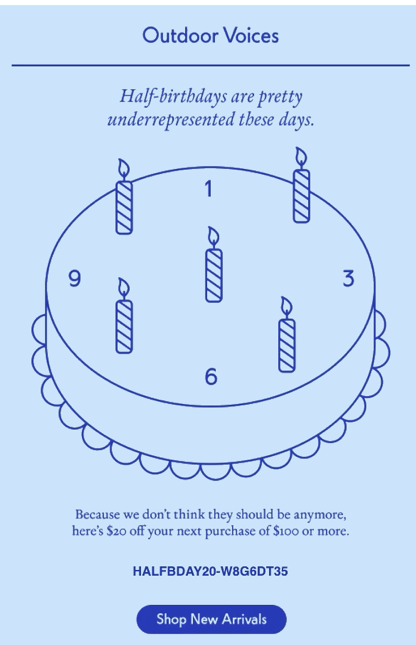
Demo email
Finally, let your subscribers view a demo of your product and prompt them with a gleaming, convincing email copy.
June Oven keeps it simple: one key post, one CTA, an accurate image of their product, and a hyperlink inside the copy to show it off further.

If you’re looking for more examples of automation marketing emails, go to reallygoodemails.com.
They bring together the best in the business world and provide you with expertise to assess deliverability and rendering.
Now that you have learned what automation email marketing is, how to set up a campaign focused on your business goals and audience, and browsed through some automation email examples, it’s time to choose the right tool to help you run your automation email marketing.
Best app for automating email marketing
AVADA Email & SMS Marketing
AVADA Marketing Automation is an excellent email marketing automation app that helps you to create, run and monitor your campaigns.
You can automatically submit a welcome sequence to new subscribers, as well as birthday greetings or any other material you want.
It can also be used to recover abandoned carts. AVADA Email & SMS Marketing also provides features for drag-and-drop email design, email capture, list segmentation, and automated email workflows.
It is a fantastic tool to use if you are searching for successful email marketing automation software.
When compared to other marketing automation applications, the pricing is relatively competitive.
It has a free-forever plan that provides 1,000 contacts and 15,000 emails. Paid plans start at $9/month for 1,000 contacts, unlimited emails, and full features.
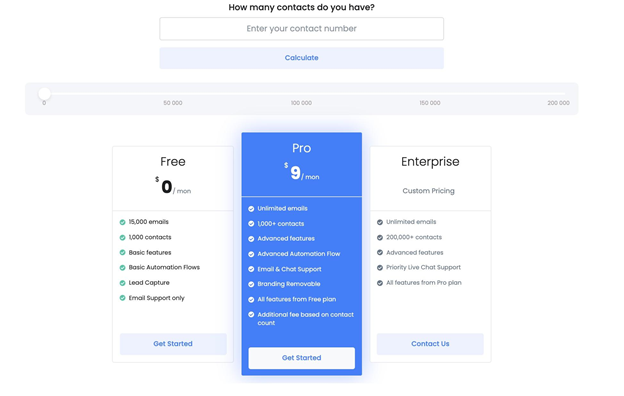
Drip
Drip, as an email drip campaign tool, has a straightforward and user-friendly GUI. In your emails, you can use its drag-and-drop components and pre-made templates.
If you own an e-commerce business, this email marketing tool is a good choice for you. Its pricing is a bit expensive for new and small businesses though.
If you have 1-500 contacts, you need to pay $19 per month. With this app, you can automate the drip email process.
GetResponse
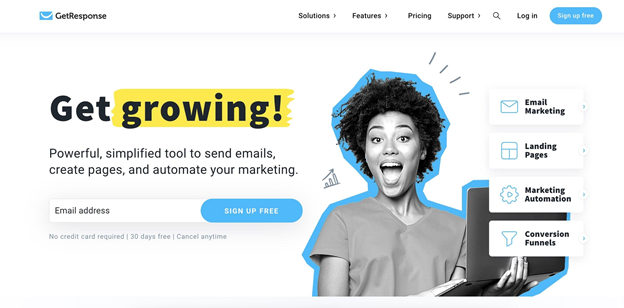
GetResponse is one of the most popular email service providers and email marketing automation tools.
Even though it did not initially mention marketing automation capabilities, it did have some useful features such as autoresponder and much more.
In this case, you can use its simple drag-and-drop interface to build workflows. Paid plans start at $15/month for 100 contacts.
Final words
That’s it! I hope that this article has provided you with valuable information about automation email marketing for eCommerce. Please feel free to leave comments below for a further discussion on this topic!
New Posts

How To Set Up Google Analytics 4 For Your BigCommerce Store






